The Rise of Mini Pigs: Myths, Realities, and Care Considerations
The popularity of mini pigs has been on the rise in recent years, capturing the hearts of many pet enthusiasts. These small versions of their larger counterparts have become increasingly sought after, often portrayed as cute, manageable, and easy to care for. However, beneath this appealing facade lie several misconceptions about their size, lifespan, and care requirements that need to be addressed. This article aims to explore the truth behind these myths, provide scientific insights into their behavior, health needs, and environmental impact, and offer a balanced perspective for potential owners.
Myth vs. Reality: Debunking Common Misconceptions
Size
One of the most prevalent myths surrounding mini pigs is their size. Many people believe that these animals remain tiny throughout their lives, similar to domesticated pets like cats or dogs. In reality, while some breeds may reach an adult weight of around 50 pounds, others can grow significantly larger, reaching weights between 100 to 200 pounds. The exact size depends on factors such as genetics, diet, and living conditions.
Lifespan
Another misconception is regarding the lifespan of mini pigs. Some individuals assume they live shorter lives compared to other household pets. Scientifically speaking, mini pigs typically live between 10 to 20 years, depending on breed, health, and care. Proper nutrition, regular veterinary check-ups, and a healthy lifestyle contribute positively to their longevity.
Care Requirements
Many prospective owners underestimate the time and effort required to care for a mini pig. Unlike traditional pets, mini pigs require more space, specific dietary needs, and mental stimulation. They are intelligent creatures with complex social structures, necessitating enrichment activities to prevent boredom and destructive behaviors.
Scientific Insights on Behavior, Health Needs, and Environmental Impact
Behavior
Mini pigs exhibit intriguing behaviors influenced by their wild ancestry. They are highly social animals that thrive in groups but can also form strong bonds with humans. Their intelligence allows them to learn tricks and respond to training methods similar to those used for dogs. Understanding and addressing their behavioral needs ensures a harmonious relationship between owner and pet.
Health Needs
Regular veterinary care is essential for maintaining the health of mini pigs. Like any animal, they are susceptible to various diseases and conditions. Preventive measures such as vaccinations, parasite control, and routine check-ups help ensure optimal health. Additionally, providing a balanced diet tailored to their nutritional requirements supports overall well-being.
Environmental Impact
When considering the environmental impact of keeping a mini pig as a pet, it’s important to note that their waste management poses unique challenges. Proper disposal of feces and urine is crucial to minimize contamination of water sources and soil. Owners must be prepared to handle this responsibly, ensuring the safety of both their pets and the environment.
Comparing Mini Pigs to Traditional Pets
While mini pigs share some similarities with traditional pets, there are notable differences that potential owners should consider. For instance, while dogs and cats are generally easier to house train and maintain within confined spaces, mini pigs require more extensive living areas to accommodate their physical activity and mental stimulation. Moreover, the dietary preferences of mini pigs differ from those of dogs and cats, requiring specialized feed formulated for swine.
Real Stories and Case Studies
Case Study 1: Sarah’s Journey
Sarah adopted a mini pig named Daisy three years ago. Initially, she was excited about having a compact, loving companion. However, as Daisy grew, so did the challenges associated with her care. Sarah learned that providing adequate space and mental stimulation was crucial for Daisy’s happiness. Despite these hurdles, Sarah remains committed to Daisy, emphasizing the importance of education and preparation before bringing home a mini pig.
Case Study 2: John’s Experience
John’s experience with his mini pig, Charlie, highlights the joys and responsibilities of ownership. He shares how Charlie’s intelligence and affectionate nature have enriched his life. However, he also discusses the need for patience and understanding when dealing with Charlie’s unique behaviors. John advises future owners to research thoroughly and prepare themselves emotionally and financially for the commitment involved.
Advice for Those Considering Adopting a Mini Pig
For individuals considering adopting a mini pig, it’s vital to approach the decision thoughtfully. Research extensively about mini pig breeds, sizes, and care requirements. Visit local shelters or breeders to gain firsthand knowledge about these animals. Ensure you have the necessary resources—both financial and emotional—to provide a loving home. Lastly, consult with veterinarians specializing in exotic animals to address any concerns regarding health and well-being.
